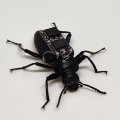A UQ PhD student has battled unforgiving mountainous terrain in Vietnam to conduct the world’s first in-depth study of the ecology of an endangered species of monkey.
Before School of Natural and Rural Systems Management student Hoang Minh Duc’s study, the only photographs of the tree-dwelling Black-shanked Douc Langer (Pygathrix nigripes) were blurred and from vast distances.
The Black-shanked Douc Langer are charcoal or black with grey back and chest and weigh up to 12kg (males) and 9kg (females). They have a bluish-white face with yellow eye-rings and a distinctive white tail that is longer than their body and hangs straight down as the animal feeds.
Mr Hoang’s maps and description of the monkey’s habitats and diet in both the wet and dry seasons will inform Vietnamese government decisions on the parks such as boundaries and the regulation of human activities there including gathering wood, according to school senior lecturer and thesis supervisor Dr Greg Baxter.
The Douc Langer is highly endangered with only an estimated 4000 left in the wild and only in the area studied by Mr Hoang. Unlike Australian national parks, the Vietnamese reserves include many villages.
“Because of this higher level of interaction between the wild animal world and humans, the government is keen to develop more specific guidelines in relation to its national parks to maximise protection for species such as the Douc Langer,” Mr Hoang said.
Mr Hoang catalogued the feeding and habitat preferences of 1867 monkeys by trekking along transects of dense forests of both the 29,000-hectare Nui Chua National Park and the 19,000-hectare Phuoc Bienh Naherc Reserve in the Annamite mountain range in Vietnam.
He covered around 50,000 hectares on foot in steep terrain, about 2000 metres above sea level over a gruelling eight months. It was mostly hot and humid but little usable water was available resulting in all food and water being carried on the backs of Mr Hoang and five porters. There were few tracks with the party often forced to cut their way through vine thickets and thorny scrub. They slept in hammocks slung between trees and fitted with mosquito nets because both parks were malaria-prone.
When Mr Hoang encountered a troop of the monkeys, varying in size from five individuals up to 45, he would observe and record their behaviour and current habitats as well as examine their droppings to determine foods eaten.
“While it was previously known the monkeys ate leaves, I established they also have a lot of fruit and flowers in their daily diet,” Mr Hoang said.
The monkeys seldom leave the safety of the 20–30-metre-high trees which has contributed to past difficulties in studying them.
Mr Hoang, who has a scholarship from the Vietnamese Government for his study, said he chose UQ and in particular UQ Gatton for his research because of its quality and international reputation.
“Australia is also a peaceful and friendly country,” he said.
Mr Hoang began his research through the Institute of Tropical Biology in Vietnam.
For more information, contact Dr Greg Baxter (+ 61 7 5460 1479) or Shirley Glaister at UQ Communications (+ 61 7 3365 2049).
.jpg)

